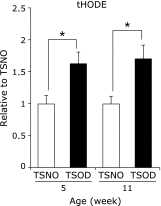Type 2 diabetes model TSOD mouse is exposed to oxidative stress at young age
- PMID: 25411529
- PMCID: PMC4227832
- DOI: 10.3164/jcbn.14-73
Type 2 diabetes model TSOD mouse is exposed to oxidative stress at young age
Abstract
Tsumura Suzuki Obese Diabetes (TSOD) mouse, a model of obese type 2 diabetes, older than around 11 weeks of age develops diabetic phenotypes. Previous studies have indicated that the development of diabetes is partly due to three loci associated with body weight and glucose homeostasis. However, little is known about the initial events triggering the development of the diabetic phenotypes in TSOD mouse. Here, we investigated the alteration of diabetes-related parameters, including the levels of blood glucose and inflammatory cytokines, and the oxidative stress status, in young TSOD mice. TSOD mice at 5 weeks of age showed increases in body weight and plasma total cholesterol level, but not hyperglycemia or impaired glucose tolerance, compared with age-matched control Tsumura Suzuki Non-Obese (TSNO) mice. Plasma tumor necrosis factor (TNF)-α and interleukin (IL)-6 were not detected in TSOD mice at 5 weeks of age. However, plasma total hydroxyoctadecadienoic acid (tHODE), a biomarker of oxidative stress, was increased in TSOD mice relative to TSNO mice at same age. The results demonstrated that young TSOD mice are exposed to oxidative stress before developing the diabetic phenotypes, and suggested that oxidative stress is an initial event triggering the development of diabetes in TSOD mice.
Keywords: TSOD mouse; hyperglycemia; inflammation; oxidative stress; type 2 diabetes.
Figures




Similar articles
-
Peripheral neuropathy in the pre-diabetic state of the type 2 diabetes mouse model (TSOD mice) involves TRPV1 expression in dorsal root ganglions.IBRO Neurosci Rep. 2022 Feb 8;12:163-169. doi: 10.1016/j.ibneur.2022.02.001. eCollection 2022 Jun. IBRO Neurosci Rep. 2022. PMID: 35199097 Free PMC article.
-
Characteristics of bone strength and metabolism in type 2 diabetic model Tsumura, Suzuki, Obese Diabetes mice.Bone Rep. 2018 Jul 21;9:74-83. doi: 10.1016/j.bonr.2018.07.004. eCollection 2018 Dec. Bone Rep. 2018. PMID: 30094297 Free PMC article.
-
Switching from singlet-oxygen-mediated oxidation to free-radical-mediated oxidation in the pathogenesis of type 2 diabetes in model mouse.Free Radic Res. 2015 Feb;49(2):133-8. doi: 10.3109/10715762.2014.985218. Epub 2014 Dec 11. Free Radic Res. 2015. PMID: 25381799
-
4-Nitroquinoline 1-Oxide-Induced Tongue and Esophagus Carcinogenesis in Obese and Diabetic TSOD Mice.World J Oncol. 2017 Aug;8(4):97-104. doi: 10.14740/wjon1038w. Epub 2017 Aug 27. World J Oncol. 2017. PMID: 29147443 Free PMC article.
-
Relationship between oxidative stress and inflammatory cytokines in diabetic nephropathy.Cardiovasc Ther. 2012 Feb;30(1):49-59. doi: 10.1111/j.1755-5922.2010.00218.x. Epub 2010 Aug 16. Cardiovasc Ther. 2012. PMID: 20718759 Review.
Cited by
-
Obesity-Linked Cancers: Current Knowledge, Challenges and Limitations in Mechanistic Studies and Rodent Models.Cancers (Basel). 2018 Dec 18;10(12):523. doi: 10.3390/cancers10120523. Cancers (Basel). 2018. PMID: 30567335 Free PMC article. Review.
-
Peripheral neuropathy in the pre-diabetic state of the type 2 diabetes mouse model (TSOD mice) involves TRPV1 expression in dorsal root ganglions.IBRO Neurosci Rep. 2022 Feb 8;12:163-169. doi: 10.1016/j.ibneur.2022.02.001. eCollection 2022 Jun. IBRO Neurosci Rep. 2022. PMID: 35199097 Free PMC article.
-
Comprehensive analysis of PPARγ agonist activities of stereo-, regio-, and enantio-isomers of hydroxyoctadecadienoic acids.Biosci Rep. 2020 Apr 30;40(4):BSR20193767. doi: 10.1042/BSR20193767. Biosci Rep. 2020. PMID: 32266936 Free PMC article.
-
Accumulation of 8-hydroxydeoxyguanosine, L-arginine and Glucose Metabolites by Liver Tumor Cells Are the Important Characteristic Features of Metabolic Syndrome and Non-Alcoholic Steatohepatitis-Associated Hepatocarcinogenesis.Int J Mol Sci. 2020 Oct 20;21(20):7746. doi: 10.3390/ijms21207746. Int J Mol Sci. 2020. PMID: 33092030 Free PMC article.
-
Characteristics of bone strength and metabolism in type 2 diabetic model Tsumura, Suzuki, Obese Diabetes mice.Bone Rep. 2018 Jul 21;9:74-83. doi: 10.1016/j.bonr.2018.07.004. eCollection 2018 Dec. Bone Rep. 2018. PMID: 30094297 Free PMC article.
References
-
- Wild S, Roglic G, Green A, Sicree R, King H. Global prevalence of diabetes: estimates for the year 2000 and projections for 2030. Diabetes Care. 2004;27:1047–1053. - PubMed
-
- Suzuki W, Iizuka S, Tabuchi M, et al. A new mouse model of spontaneous diabetes derived from ddY strain. Exp Anim. 1999;48:181–189. - PubMed
LinkOut - more resources
Full Text Sources
Other Literature Sources

